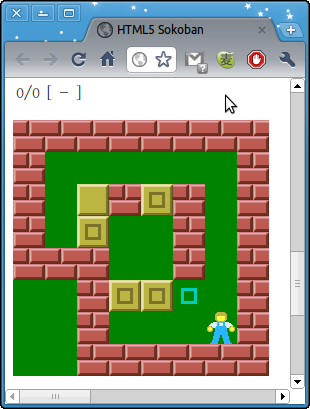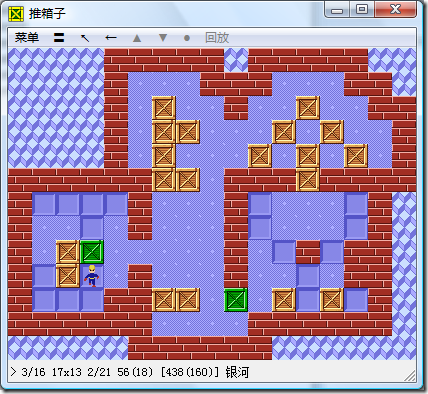推箱子游戏简介
推箱子是一款经典的电子游戏,要求玩家在二维地图上把箱子推到指定地点,当中牵涉到大量的空间逻辑推理。HTML5 Sokoban 是一个非常不错的在线推箱子的网页。推箱子关卡一般用XSB格式来保存和交流,解答步骤则使用LURD格式,请参见:XSB和LURD格式简介。
XSB格式规定使用以下符号:
- @ ==> 人 man
- + ==> 人在目标点 man on goal
- $ ==> 箱子 box
- * ==> 箱子在目标点 box on goal
- # ==> 墙 wall
- . ==> 目标点 goal
- - ==> 地板 floor,还可以使用空格或者下划线表示。
LURD格式规定使用以下八个拉丁字母(小写字母表示移动,大写字母表示推动):
- l 或 L ==> 左 Left
- r 或 R ==> 右 Right
- u 或 U ==> 上 Up
- d 或 D ==> 下 Down
从解答步骤还原关卡地图
有一天,我突然想到,能不能从推箱子的解答步骤还原出关卡地图来呢?因为LURD数据已经包含了足够的信息,可以据此还原出一个最简的关卡地图出来。下面就是实现这个想法的 Lurd2Xsb.cs 程序:
001: using System;
002: using System.Text;
003: using System.Drawing;
004:
005: namespace Skyiv.Ben.Game
006: {
007: public sealed class Lurd2Xsb
008: {
009: void SetBrick(byte[,] map, int x, int y) { map[x, y] = 8; }
010: void SetFloor(byte[,] map, Point pt) { map[pt.X, pt.Y] |= 1; }
011: void SetGoal(byte[,] map, Point pt) { map[pt.X, pt.Y] |= 2; }
012: void SetBox(byte[,] map, Point pt) { map[pt.X, pt.Y] |= 4; }
013: void UnsetBox(byte[,] map, Point pt) { map[pt.X, pt.Y] &= 0xFB; }
014: bool HasBox(byte[,] map, int x, int y) { return (map[x, y] & 4) != 0; }
015: bool IsGoal(byte[,] map, int x, int y) { return (map[x, y] & 2) != 0; }
016: bool IsFloor(byte[,] map, int x, int y) { return (map[x, y] & 1) != 0; }
017: bool IsBrick(byte[,] map, int x, int y) { return map[x, y] == 8; }
018: bool IsWall(byte[,] map, int x, int y) { return map[x, y] == 0; }
019: bool IsBrickOrWall(byte[,] map, int x, int y) { return IsBrick(map, x, y) || IsWall(map, x, y); }
020:
021: void MarkBrick(byte[,] map, int x, int y)
022: {
023: if (!IsWall(map, x, y)) return;
024: if (!IsBrickOrWall(map, x - 1, y - 1)) return;
025: if (!IsBrickOrWall(map, x - 1, y + 1)) return;
026: if (!IsBrickOrWall(map, x + 1, y - 1)) return;
027: if (!IsBrickOrWall(map, x + 1, y + 1)) return;
028: if (!IsBrickOrWall(map, x - 1, y)) return;
029: if (!IsBrickOrWall(map, x + 1, y)) return;
030: if (!IsBrickOrWall(map, x, y - 1)) return;
031: if (!IsBrickOrWall(map, x, y + 1)) return;
032: SetBrick(map, x, y);
033: }
034:
035: int GetX(byte[,] map, int y0, int y1, int x, int x2)
036: {
037: for (var y = y0; y < y1; y++)
038: if (!IsBrick(map, x, y)) return x;
039: return x2;
040: }
041:
042: int GetY(byte[,] map, int x0, int x1, int y, int y2)
043: {
044: for (var x = x0; x < x1; x++)
045: if (!IsBrick(map, x, y)) return y;
046: return y2;
047: }
048:
049: Rectangle GetRectangle(byte[,] map)
050: {
051: int x0 = 1, y0 = 1, x1 = map.GetLength(0) - 2, y1 = map.GetLength(1) - 2;
052: x0 = GetX(map, y0, y1, x0, x0 + 1);
053: x1 = GetX(map, y0, y1, x1, x1 - 1);
054: y0 = GetY(map, x0, x1, y0, y0 + 1);
055: y1 = GetY(map, x0, x1, y1, y1 - 1);
056: return Rectangle.FromLTRB(x0, y0, x1, y1);
057: }
058:
059: string GetXsb(byte[,] map, Point man)
060: {
061: var rect = GetRectangle(map);
062: for (var y = rect.Top; y <= rect.Bottom; y++)
063: for (var x = rect.Left; x <= rect.Right; x++)
064: MarkBrick(map, x, y);
065: rect = GetRectangle(map);
066: var xsb = new StringBuilder();
067: for (var y = rect.Top; y <= rect.Bottom; y++)
068: {
069: for (var x = rect.Left; x <= rect.Right; x++)
070: {
071: if (IsGoal(map, x, y))
072: {
073: if (man.X == x && man.Y == y) xsb.Append('+');
074: else if (HasBox(map, x, y)) xsb.Append('*');
075: else xsb.Append('.');
076: }
077: else if (IsFloor(map, x, y))
078: {
079: if (man.X == x && man.Y == y) xsb.Append('@');
080: else if (HasBox(map, x, y)) xsb.Append('$');
081: else xsb.Append('-');
082: }
083: else if (IsBrick(map, x, y)) xsb.Append('_');
084: else xsb.Append('#');
085: }
086: xsb.AppendLine();
087: }
088: return xsb.ToString();
089: }
090:
091: void LeftOrRight(byte[,] map, ref Point man, int step)
092: {
093: man.X += step;
094: if (HasBox(map, man.X, man.Y)) UnsetBox(map, man);
095: else SetGoal(map, man);
096: man.X -= step;
097: SetBox(map, man);
098: man.X -= step;
099: SetFloor(map, man);
100: }
101:
102: void UpOrDown(byte[,] map, ref Point man, int step)
103: {
104: man.Y += step;
105: if (HasBox(map, man.X, man.Y)) UnsetBox(map, man);
106: else SetGoal(map, man);
107: man.Y -= step;
108: SetBox(map, man);
109: man.Y -= step;
110: SetFloor(map, man);
111: }
112:
113: byte[,] GetMap(string lurd, Size size, ref Point man)
114: {
115: var map = new byte[size.Width, size.Height];
116: SetFloor(map, man);
117: for (var i = lurd.Length - 1; i >= 0; i--)
118: {
119: switch (lurd[i])
120: {
121: case 'l': man.X++; SetFloor(map, man); break;
122: case 'r': man.X--; SetFloor(map, man); break;
123: case 'u': man.Y++; SetFloor(map, man); break;
124: case 'd': man.Y--; SetFloor(map, man); break;
125: case 'L': LeftOrRight(map, ref man, -1); break;
126: case 'R': LeftOrRight(map, ref man, 1); break;
127: case 'U': UpOrDown(map, ref man, -1); break;
128: case 'D': UpOrDown(map, ref man, 1); break;
129: }
130: }
131: return map;
132: }
133:
134: Rectangle GetBoundary(string lurd)
135: {
136: var boundary = new Rectangle(0, 0, 1, 1);
137: var man = new Point();
138: for (var i = lurd.Length - 1; i >= 0; i--)
139: {
140: switch (lurd[i])
141: {
142: case 'l': case 'L': man.X++; if (boundary.Right <= man.X) boundary.Width++; break;
143: case 'r': case 'R': man.X--; if (boundary.Left > man.X) { boundary.Width++; boundary.X--; } break;
144: case 'u': case 'U': man.Y++; if (boundary.Bottom <= man.Y) boundary.Height++; break;
145: case 'd': case 'D': man.Y--; if (boundary.Top > man.Y) { boundary.Height++; boundary.Y--; } break;
146: }
147: }
148: return boundary;
149: }
150:
151: public string GetXsbFromLurd(string lurd)
152: {
153: var boundary = GetBoundary(lurd);
154: var size = new Size(boundary.Width + 6, boundary.Height + 6);
155: var man = new Point(3 - boundary.X, 3 - boundary.Y);
156: var map = GetMap(lurd, size, ref man);
157: return GetXsb(map, man);
158: }
159:
160: static void Main()
161: {
162: Console.Write(new Lurd2Xsb().GetXsbFromLurd(Console.In.ReadToEnd()));
163: }
164: }
165: }
简要说明:
- GetXsbFromLurd 方法根据输入的LURD数据还原出XSB格式的最简关卡地图。
- GetBoundary 方法根据输入的LURD数据计算出地图的边界。
- GetMap 方法根据输入的LURD数据生成关卡地图的二维字节数组表示。
- LeftOrRight 和 UpOrDown 方法处理LURD数据中推动箱子的步骤。
- GetXsb 方法根据关卡地图的二维字节数组表示生成XSB格式数据。
- GetRectangle 方法判断二维字节数组中实际表示数据的边界范围。
- MarkBrick 方法标记砖块(相当于人不可到达的空地,作用和墙是一样的)。
- 第 9 到 19 行的一系列 SetXXX 和 IsXXX 等方法都是简单地对二维字节数组操作。
这个程序的主要算法体现在 GetMap 方法中,要点是:
- 整个地图初始化为 wall 。
- 从解法步骤的最后一步往前倒推,直到第一步。
- 人所走过的每一步的位置都标记为 floor。
- 如果步骤是大写字母,即有推动箱子,则人的当前位置标记为箱子。根据前进方向上是否有箱子设置该前进方向的位置:
- 有箱子,则移出箱子。
- 无箱子,则标记为 goal。
程序使用示例
比如说 HTML5 Sokoban 网页上 m1 关卡集第 12 关如下所示:

经过49步后通关,其LURD数据如下所示(m1-12.lurd):
uululldRdRluurDrDDrddlluRuuulldRurDDrrrddllUdlluR
那么,我们执行以下命令:
Lurd2Xsb.exe < m1-12.lurd > m1-12.xsb
得到的XSB数据如下所示:
#####____ #---##___ #-$--#___ ##-$-#### _###@.--# __#--.#-# __#-----# __#######
将以上XSB数据在 HTML5 Sokoban 网页上载入关卡,如下图所示:

可见该程序较好地还原了关卡地图。
不能准确还原的情况


左图是 HTML5 Sokoban 网页中 m1 关卡集的第 107 关。右图是使用本程序还原以下解法步骤(44 moves, 10 pushs)的结果:
lllURuulDrddrruuuuullDDDuuulllddRRdrUllluurD
可以看出,这两个图有很大的不同。原因是该关卡中有十个箱子已经在目标点中,而且其中的六个箱子在解答过程中没有被推动过,自然就被本程序判断为墙了。如果需要准确还原出左图的关卡地图,可以使用以下解法步骤(138 moves, 22 pushs):
lllURuulDrddrruuuuulllDurrrdddddlluulUrdddrruuuuullDDDuuulllddRRdrUllluurrrrrddLrdLruuulDrddlUruulllllddrrRldRlulldRlddrUluurDurrdLulluurD
解法步骤不合法的情况



上面三幅关卡地图分别是从“LURD”、“Rrr”和“RL”解法步骤中还原出来的。对于这些不合法的解法步骤,本程序也不报错。本程序只保证合法的解法步骤能够还原出正确的关卡地图。此外,本程序还忽略解法步骤中“lurdLURD”以外的所有字符。
智能手机上的推箱子程序
2007年10月我还写了系列随笔:使用 C# 开发智能手机软件:推箱子。当时使用的数据格式有所不同,但是可以写一个简单的 Xsb2Bxa 程序来进行转换。下图就是转换后载入到 PushBox 软件中的其中一个关卡:

下面就是 Xsb2Bxa.cs 程序:
01: using System;
02: using System.IO;
03: using System.Text;
04:
05: namespace Skyiv.Ben.Game
06: {
07: sealed class Xsb2Bxa
08: {
09: void TransformXsb(string name, StringBuilder sb)
10: {
11: foreach (var line in File.ReadLines(name + ".xsb"))
12: {
13: if (line.Length == 0) continue;
14: foreach (var c in line)
15: {
16: switch (c)
17: {
18: case '#': sb.Append('#'); break;
19: case '@': sb.Append('('); break;
20: case '+': sb.Append(')'); break;
21: case '$': sb.Append('x'); break;
22: case '*': sb.Append('X'); break;
23: case '.': sb.Append('+'); break;
24: case '-': sb.Append('-'); break;
25: case ' ': sb.Append('-'); break;
26: case '_': sb.Append('%'); break;
27: }
28: }
29: sb.AppendLine();
30: }
31: }
32:
33: void TransformLurd(string name, StringBuilder sb)
34: {
35: var file = name + ".lurd";
36: if (!File.Exists(file)) return;
37: sb.Append(':');
38: foreach (var c in File.ReadAllText(file))
39: {
40: switch (c)
41: {
42: case 'l': sb.Append('N'); break;
43: case 'u': sb.Append('O'); break;
44: case 'r': sb.Append('L'); break;
45: case 'd': sb.Append('M'); break;
46: case 'L': sb.Append('S'); break;
47: case 'U': sb.Append('T'); break;
48: case 'R': sb.Append('Q'); break;
49: case 'D': sb.Append('R'); break;
50: }
51: }
52: sb.AppendLine();
53: }
54:
55: string GetBxaFromXsbAndLurd(string name)
56: {
57: var sb = new StringBuilder();
58: TransformXsb(name, sb);
59: TransformLurd(name, sb);
60: return sb.ToString();
61: }
62:
63: void Run()
64: {
65: using (var sw = new StreamWriter("ben.bxa", false, Encoding.GetEncoding("GB2312")))
66: {
67: sw.WriteLine("!银河");
68: var count = 0;
69: foreach (var file in Directory.GetFiles(".", "*.xsb"))
70: {
71: var name = Path.GetFileNameWithoutExtension(file);
72: sw.WriteLine("'[{0}] {1}", ++count, name);
73: sw.WriteLine(GetBxaFromXsbAndLurd(name));
74: }
75: }
76: }
77:
78: static void Main()
79: {
80: try
81: {
82: new Xsb2Bxa().Run();
83: }
84: catch (Exception ex)
85: {
86: Console.WriteLine(ex.Message);
87: }
88: }
89: }
90: }
源代码下载
本文中的所有源代码可以到 https://bitbucket.org/ben.skyiv/lurd2xsb/downloads 页面下载。
也可以使用 hg clone https://bitbucket.org/ben.skyiv/lurd2xsb 命令下载。
关于 hg ,请参阅 Mercurial 备忘录。
来源:https://www.cnblogs.com/skyivben/archive/2011/07/03/2096801.html